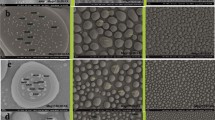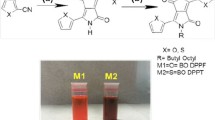Abstract
Electrochemical formation and properties of intrinsically conducting homo- and copolymers of polypyrrole (PPy), poly-N-methylpyrrole (PNMPy), polyindole (PIn), poly(pyrrole-indole) [P(Py-In)], poly(N-methylpyrrole-indole) [P(NMPy-In)] on gold electrode were studied comparatively. Characterization of the samples was performed by cyclic voltammetry, in situ UV–Vis and FTIR spectroscopy methods, in situ resistance measurements and scanning electron microscopy (SEM) techniques. The voltammograms exhibited different behavior for various concentration ratios of the monomer in the feed with redox peaks observed at different positions. Positive shifts of the oxidation peaks were observed for copolymers synthesized using higher concentrations of monomer during the electropolymerization. In situ UV–Vis and FTIR spectroscopy results showed a spectroscopic behavior of the copolymers intermediate between those of the homopolymers. The resistance of copolymers generally grew with increasing (In)/(Py) and (In)/(NMPy) concentration ratio. This was most likely due to a smaller amount of pyrrole units in the copolymer backbone yielding a less extended π-conjugation system along the copolymer backbone. In comparison, the resistance of P(NMPy-In) was higher than that of P(Py-In) copolymers. The morphology of polymers and copolymers was studied and compared using SEM. The SEM micrographs showed similarities between homo- and copolymers. A mechanism was suggested for the formation of copolymers proceeding via radical cations of indole, pyrrole and that of the possibly formed copolymer.








Similar content being viewed by others
References
Nalwa HS (1997) Handbook of organic conductive molecules and polymers, vols 2 and 3. John Wiley & Sons Ltd, England
Kumar D, Sharma RC (1998) Advances in conductive polymers. Eur Polym J 34:1053–1060
Skotheim TA, Elsenbaumer RL, Reynolds JR (1998) Handbook of conducting polymers, vol 2. Marcel Dekker, New York
Li N, Shan D, Xue H (2007) Electrochemical synthesis and characterization of poly(pyrrole-co-tetrahydrofuran) conducting copolymer. Eur Polym J 43:2532–2539
Li XG, Li A, Huang MR, Liao Y, Lu YG (2010) Efficient and scalable synthsis of pure polypyrrole nanoparticles applicable for advanced nanocomposites and carbon nanoparticles. J Phys Chem C 114:19244–19255
Li XG, Wei F, Huang MR, Xie YB (2007) Facile synthesis and intrinsic conductivity of novel pyrrole copolymer nanoparticles with inherent self stability. J Phys Chem Pol Phys 111:5829–5836
Talbi H, Monard G, Loos M, Billaud D (1999) Theoretical investigation of the monomer reactivity in polyindole derivatives. Synth Met 101:115–116
Xu JK, Nie GM, Zhang SS, Han XJ, Hou J, Pu SZ (2005) Electrosyntheses of freestanding polyindole films in boron trifluoride diethyl etherate. J Polym Sci Pol Chem 43:1444–1453
Billaud D, Maarouf EB, Hannecart E (1994) An investigation of electrochemically and chemically polymerized indole. Mater Res Bull 29:1239–1246
Nie G, Han X, Hou J, Zhang S (2007) Low-potential electrochemical polymerization of 5-fluoroindole and characterization of its polymers. J Electroanal Chem 604:125–132
Dhanalashmi K, Sarawathi R (2001) Electrochemical preparation and characterization of conducting copolymers: poly (pyrrole-co-indole). J Mater Sci 36:4107–4115
Arjomandi J, Holze R (2013) A spectroelectrochemical study of conducting pyrrole-N-methylpyrrole copolymers in nonaqueous solution. J Solid State Electochem 17:1881–1889
Tüken T, Yazıcı B, Erbil M (2005) Electrochemical synthesis of polyindole on nickel-coated mild steel and its corrosion performance. Surf Coat Tech 200:2301–2309
Arjomandi J, Holze R (2008) Electrochemical preparation and in situ characterization of poly(3-methylpyrrole) and poly(3-methylpyrrole-cyclodextrin) films on gold electrodes. Cent Eur J Chem 6:199–207
Ali Shah AH, Holze R (2006) Spectroelectrochemistry of aniline-o-aminophenol co-polymers. Electrochim Acta 52:1374–1382
Arjomandi J, Shah AA, Bilal S, Hoang HV, Holze R (2011) In situ Raman and UV–Vis spectroscopic studies of polypyrrole and poly(pyrrole-2,6-dimethyl-β-cyclodextrin). Spectrochim Acta A 78:1–6
Bilal S, Holze R (2007) In situ UV–Vis spectroelectrochemistry of poly (o-phenylenediamine-co-m-toluidine). Electrochim Acta 52:5346–5356
Köleli F, Arslan Y, Düdükcü M (2002) Preparation and SEESR-spectroscopic investigations of indole/pyrrole copolymers in aprotic medium. Synth Met 129:47–52
Pandey PC, Prakash R (1998) Characterization of Electropolymerized Polyindole. J Electrochem Soc 145:4103–4107
Arjomandi J, Safdar S, Malmir M (2012) In situ uv-visible spectroelectrochemistry and cyclic voltammetry of conducting N-methylpyrrole: indole co-polymers on gold electrode. J Electrochem Soc 159:E73–E81
Arjomandi J, Holze R (2007) In situ characterization of N-methylpyrrole and (N-methylpyrrole-cyclodextrin) polymers on gold electrodes in aqueous and nonaqueous solution. Synth Met 157:1021–1028
Holze R, Lippe J (1990) A method for electrochemical in situ conductivity measurements of electrochemically synthesized intrinsically conducting polymers. Synth Met 38:99–105
Bilal S, Holze R (2006) Electrochemical copolymerization of o-toluidine and o-phenylenediamine. J Electroanal Chem 592:1–13
Asavapiriyanont S, Chandler GK, Gunawardena GA, Pletcher D (1984) The electrodeposition of polypyrrole films from aqueous solutions. J Electroanal Chem 177:229–244
Asavapiriyanont S, Chandler GK, Gunawardena GA, Pletcher D (1984) The electrodeposition of poly-N-methylpyrrole films from aqueous solutions. J Electroanal Chem 177:245–251
Yakushi K, Lauchlan LJ, Clarke TC, Street GB (1983) Optical study of polypyrrole perchlorate. J Chem Phys 79:4774–4778
Chandresekhar P (1999) Conducting polymers, fundamentals and applications. Kluwer Academic Publishers, New York
Tüken T, Yazıcı B, Erbil M (2006) The use of polyindole for prevention of copper corrosion. Surf Coat Tech 200:4802–4809
Brédas JL, Thémans B, Fripiat JG, André JM, Chance RR (1984) Highly conducting polyparaphenylene, polypyrrole, and polythiophene chains: an ab initio study of the geometry and electronic-structure modifications upon doping. Phys Rev B 29:6761–6773
Zotti G, Schiavon G (1989) Spectroclectrochemical determination of polarons in polypyrrole and polyaniline. Synth Met 30:151–158
Unal HI, Sahan B, Erol O (2012) Investigation of electrokinetic and electrorheological properties of polyindole prepared in the presence of a surfactant. Mater Chem Phys 134:382–391
Talbi H, Billaud D (1998) Electrochemical properties of polyindole and poly (5-cyanoindole) in LiClO4–acetonitrile and in HCl and HClO4 solutions. Synth Met 93:105–110
Davidson RG, Turner TG (1998) An IR spectroscopic study of the electrochemical reduction of polypyrrole doped with dodecylsulfate anion. Synth Met 72:121–128
Hamann CH, Holze R, Köleli F (1990) ESR spectroscopy in situ detection radical intermediates in the electropolymerization of nitrogenous. Dechem Monogr 121:297–319
Sadki S, Schottland P, Brodie N, Sabouraud G (2000) The mechanisms of pyrrole electropolymerization. Chem Soc Rev 29:283–293
Li XG, Liu YW, Huang MR, Peng S, Gong LZ, Moloney MG (2010) Simple efficient synthesis of strongly luminescent polypyrene with intrinsic conductivity and high carbon yield by chemical oxidative polymerization of pyrene. Chemistry 16:4803–4813
Choi KM, Kim CY, Kim KH (1992) Polymerization mechanism and physicochemical properties of electrochemically prepared polyindole tetrafluoroborate. J Phys Chem 96:3782–3788
Yurtsever M, Yurtsever E (2002) A DFT study of polymerization mechanisms of indole. Polymer 43:6019–6025
Acknowledgments
Sponsorship of this work by Bu-Ali Sina University is gratefully appreciated.
Author information
Authors and Affiliations
Corresponding author
Rights and permissions
About this article
Cite this article
Arjomandi, J., Malmir, M. & Holze, R. A comparative spectroelectrochemistry of homo- and copolymerization of pyrrole and N-methylpyrrole with indole on a gold electrode. Iran Polym J 25, 1–13 (2016). https://doi.org/10.1007/s13726-015-0397-1
Received:
Accepted:
Published:
Issue Date:
DOI: https://doi.org/10.1007/s13726-015-0397-1




